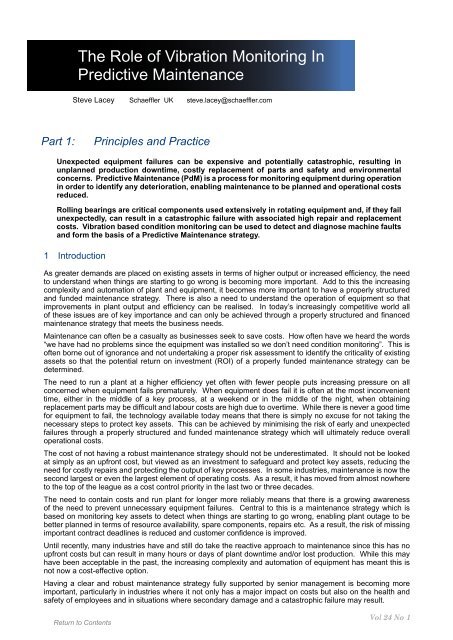AMMJ - Library
AMMJ - Library
AMMJ - Library
You also want an ePaper? Increase the reach of your titles
YUMPU automatically turns print PDFs into web optimized ePapers that Google loves.
The Role of Vibration Monitoring In<br />
Predictive Maintenance<br />
Steve Lacey Schaeffler UK steve.lacey@schaeffler.com<br />
Part 1: Principles and Practice<br />
Unexpected equipment failures can be expensive and potentially catastrophic, resulting in<br />
unplanned production downtime, costly replacement of parts and safety and environmental<br />
concerns. Predictive Maintenance (PdM) is a process for monitoring equipment during operation<br />
in order to identify any deterioration, enabling maintenance to be planned and operational costs<br />
reduced.<br />
Rolling bearings are critical components used extensively in rotating equipment and, if they fail<br />
unexpectedly, can result in a catastrophic failure with associated high repair and replacement<br />
costs. Vibration based condition monitoring can be used to detect and diagnose machine faults<br />
and form the basis of a Predictive Maintenance strategy.<br />
1 Introduction<br />
As greater demands are placed on existing assets in terms of higher output or increased efficiency, the need<br />
to understand when things are starting to go wrong is becoming more important. Add to this the increasing<br />
complexity and automation of plant and equipment, it becomes more important to have a properly structured<br />
and funded maintenance strategy. There is also a need to understand the operation of equipment so that<br />
improvements in plant output and efficiency can be realised. In today’s increasingly competitive world all<br />
of these issues are of key importance and can only be achieved through a properly structured and financed<br />
maintenance strategy that meets the business needs.<br />
Maintenance can often be a casualty as businesses seek to save costs. How often have we heard the words<br />
“we have had no problems since the equipment was installed so we don’t need condition monitoring”. This is<br />
often borne out of ignorance and not undertaking a proper risk assessment to identify the criticality of existing<br />
assets so that the potential return on investment (ROI) of a properly funded maintenance strategy can be<br />
determined.<br />
The need to run a plant at a higher efficiency yet often with fewer people puts increasing pressure on all<br />
concerned when equipment fails prematurely. When equipment does fail it is often at the most inconvenient<br />
time, either in the middle of a key process, at a weekend or in the middle of the night, when obtaining<br />
replacement parts may be difficult and labour costs are high due to overtime. While there is never a good time<br />
for equipment to fail, the technology available today means that there is simply no excuse for not taking the<br />
necessary steps to protect key assets. This can be achieved by minimising the risk of early and unexpected<br />
failures through a properly structured and funded maintenance strategy which will ultimately reduce overall<br />
operational costs.<br />
The cost of not having a robust maintenance strategy should not be underestimated. It should not be looked<br />
at simply as an upfront cost, but viewed as an investment to safeguard and protect key assets, reducing the<br />
need for costly repairs and protecting the output of key processes. In some industries, maintenance is now the<br />
second largest or even the largest element of operating costs. As a result, it has moved from almost nowhere<br />
to the top of the league as a cost control priority in the last two or three decades.<br />
The need to contain costs and run plant for longer more reliably means that there is a growing awareness<br />
of the need to prevent unnecessary equipment failures. Central to this is a maintenance strategy which is<br />
based on monitoring key assets to detect when things are starting to go wrong, enabling plant outage to be<br />
better planned in terms of resource availability, spare components, repairs etc. As a result, the risk of missing<br />
important contract deadlines is reduced and customer confidence is improved.<br />
Until recently, many industries have and still do take the reactive approach to maintenance since this has no<br />
upfront costs but can result in many hours or days of plant downtime and/or lost production. While this may<br />
have been acceptable in the past, the increasing complexity and automation of equipment has meant this is<br />
not now a cost-effective option.<br />
Having a clear and robust maintenance strategy fully supported by senior management is becoming more<br />
important, particularly in industries where it not only has a major impact on costs but also on the health and<br />
safety of employees and in situations where secondary damage and a catastrophic failure may result.<br />
Vol 24 No 1

















